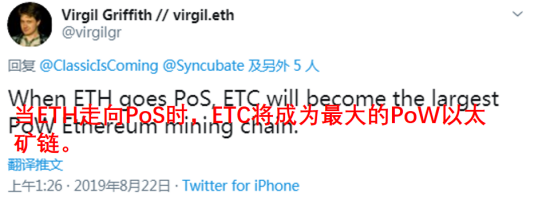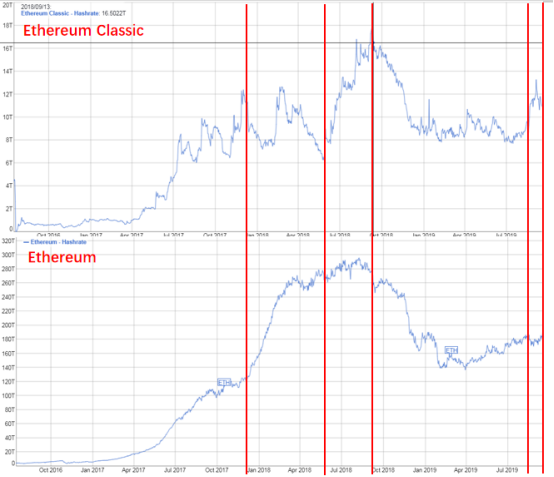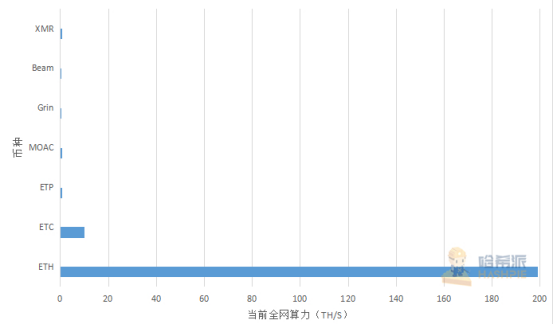2.0 is about to set sail. Will Ethereum turn to PoS to be an ETC counterattack?
"Ethernet will become the largest PoW ether mine chain when it turns to PoS!" – As Ethereum 2.0 moves closer, the topic of whether ETC will inherit ETH power and price is frequently mentioned again.

Image taken from: Twitter of the Ethereum developer Virgil Griffith

Image taken from: Twitter by Dan Williams
Some people think that this is an opportunity for ETC, it will have the possibility of surpassing ETH; some people think that it is the Ethereum, known as the "doomsday chariot", with a market value of more than 30 times and nearly 20 times the power gap. Classics are simply jokes…. but compared to ETC, will it catch up with ETH, and it is worthwhile to delve into the possibility that the Ethereum classics can be successfully leaked, thereby enhancing a wave of market influence?
- Facebook releases new version of LibraBFT protocol to reduce network complexity
- The Fold App is financing $2.5 million, and users can use BTC to buy clothes or pizza while earning BTC
- Wanxiang and Xiao Feng's blockchain map: you can see the "tip of the iceberg"

Data from: Coinmarketcap, Bitinfocharts (Note: USD)
Stick to ETH or return ETC mine chain?
Similar to BTC and BCH, there is also a relationship between the ETH and ETC mine chains of the same origin. Last month, with the heat of the Atlantis hard fork upgrade, the Ethereum classic began to increase linearly from August 19, and the monthly increase was over 35%. On the contrary, the Ethereum network was calculated from August 17th. There was a slight downward trend and it fell by 7.5 percentage points during the week. During the period of the surge in the ETC mine chain from May to September last year, the Ethereine mine chain also experienced a decline in computing power.

ETH and ETC network computing power history (picture cut from: bitinfocharts.com)
However, this switching trend is not obvious. Since the birth of ETC, the two mine chains have maintained a multiple of the gap, and gradually increased under the eruption of Ethereum in 2017; intercepted ETH and ETC so far The power gap between the two has widened to nearly 20 times. In addition, it can be seen from the fact that the fluctuation of the mining power of the graphics card is consistent with the trend of the ETH mine chain computing power, even if the mining revenue of the Ethereum is decreasing or lower than other graphics cards, From the power to switch to ETC or other GPU mine chain, most Ethereum miners still tend to stay behind ETH or directly shut down .

Left: Comparison of the total network computing power of each graphics card currency over time; right: the calculation of the computing power of the main graphics card mining currency
(Data from: wk588, bitinfocharts)
The reason for the miners to stick to the ETH mine chain is simple, that is, stability and market volume. As a blockchain network that dominates most of GPU's mining power, Ethereum has a leading edge in terms of market capitalization, trading depth and market influence; it is more suitable for miners than other graphics card mining coins. Digging. For retail miners, although it is easy to carry out the operation of “which income is high and which is excavated”, the small currency is unstable and the dividend period is limited. When the short-term premium is wiped out, the retail miners have to find the next currency to be digging. As far as the big mine owners are concerned, a large amount of switching power may lead to the shackles of other currencies. If the small part of the switching power is unstable, the revenue will still not be able to be settled. The Panda Mine Pool also said earlier that the current mining scale of most of the graphics card mining currency is not enough to accept a large number of potential miners who have retired from Ethereum. Most of the Ethereal miners will continue to prefer to stay in Ethereum. To a large extent, the persistence of miners will also benefit the market's support for Ethereum prices.

The current network computing power comparison of the graphics card mining currency (data from: wk588.com; time: September 25, 2019)
Take the Ethereum classic as an example. 51% of attacks occurred at the beginning of this year. According to data from Gas Tracker, at 0:00 on January 7th, Beijing time, the calculation power of a private mining pool (starting at address 0x3ccc8f74) suddenly rose from 300GH/s to more than 5TH/s, accounting for 56% of the ETC network in that time period; This resulted in an ETC double flower transaction with a total value of over one million dollars (data from: Coinbase). Although the attack did not have much impact on the ETC price and the network itself, it just confirmed the danger of switching the computing power to the currency. This may be one of the reasons why the ETC and ETH mining revenues are quite similar in recent months, and the calculation power between the two mine chains is still quite different.

Changes in ETC and ETH mining revenues since November 2018 (data from: wk588)
To some extent, continuing to dig ETH is the unspeakable insistence of most Ethereum miners. Therefore, even if Ethereum officially opened Staking on January 3rd next year, as long as the ETH mining revenue is positive, there will be no large amount of withdrawals in a certain period of time ; unless the EIP7011 is involved in the PoW/PoS hybrid mechanism stage The mine reward distribution method was adopted.
According to EIP7011, this stage will reduce the PoW block reward to 0.6 ETH; according to theoretical calculations, the ETH price will increase by at least 62 percentage points without considering the difficulty bomb detonation and the ETC's block rate to maintain the current level. To $278 or the net computing power dropped by 42% to below 100TH/s, the Ethereum miners can barely maintain the balance between revenue and electricity. However, from the past development progress and operation, Ethereum will not rashly reduce the PoW mining award until the Beacon chain fails to operate stably. Moreover, the PoW mechanism is still dominated by the ETH chain at this stage, and only a small number of blocks will Generated by the PoS mechanism.
Will ETH use PoS + ETC to reduce production, will it be a classic opportunity for Ethereum?
Before 2021 (completely switched to the PoS mechanism), in addition to ETH officially launched Staking, the more threatening to the Ethereum miners should be the unknown number of difficulty bombs. The difficulty bomb that was repeatedly postponed, the next predicted detonation time is March next year. If it is officially launched at that time, the Ethernet network PoW will speed up from the current 13 seconds to 38 seconds in the next four months. This means that in the current block rewards, the ETH excavated in the day under the PoW mechanism in June 2020 will be reduced to one-third of the current stage. And in the block rewards are divided by the PoS mechanism and the difficulty bomb, next year Q2 Ethereum miners always have to make a choice to stay .

Image taken from: Twitter by Ethhub founder Eric Conner
For miners who have better equipment and power cost advantages, they may still be able to support it for a while; but most miners who can't make ends meet or even dig out ETH will have to shut down. Just as in the two difficulty bomb explosions in 2017 and 2018, most of the computing power will continue to flee the ETH network. But the difference is that ETH officially opened Staking and gradually turned to PoS next year, Ethereum miners will no longer have the option of waiting for the opportunity to calculate the power to return ETH. After leaving the Ethereum mine chain, they can only choose to switch computing power, let the graphics card return to the traditional market or continue to stay in the ETH chain to participate in Staking.

Left: The situation of the Ethereum block reward day; right: the change of the calculation power of Ethereum over the years
(Image courtesy of etherscan, bitinfocharts)
However, from the current situation, it is less likely that the Ethereum miners will choose to participate in Staking. Aside from the preliminary fixed-cost investment of the miners, the ETS's PoS agreement itself has a lot of uncertainty; and the pledge of the ETH to obtain the BETH operation in the Staking process is irreversible, which will make many ordinary users deterred because this This means that users will not be able to use and trade ETHs that are locked on the Beacon chain until ETH successfully switches to the PoS mechanism. As for the choice of letting the graphics card return to the traditional market, it is not realistic. Earlier, the fish pond staff and Xu Wei said in an interview with the Planet Daily that if NVIDIA's graphics card can carry new value in deep learning and video rendering, miners need resources to find buyers; and B-side demand is too concentrated. Miners simply can't get it. Assuming that a large company has such a demand, it is likely that it will need 100,000 graphics cards at a time; it is better to mine directly.
This analysis, switching the computing power, looking for the new head currency of the graphics card mining is the stage is more in line with the choice of the Ethereum miners. In the absence of new graphics card mining star currency, ETC with relatively stable performance and relatively good market depth is some of the most preferable .

Comparison of the top 20 graphics cards in the market capitalization (data from: Coinmarketcap, wk588)
Although the classic market value of Ethereum is not as good as the Monroe coin that also supports the mining of graphics cards, it has more online exchanges, higher daily trading volume, and higher computing power. In the face of profit-seeking miners, in addition to mining revenues and prices, the depth of trading is also the point of consideration for them, especially for large miners; otherwise, the coins that have been dug have no rivals in the exchange, and it is no good to dig. on the other hand. For miners who buy AMD graphics cards (high efficiency and low cost but difficult to transform) and ant E3 mining machines (focus on Ethash algorithm), the switchable currency is very limited; the same as ETH and the difficulty bomb has been removed. ETC is also a more suitable choice for them.

Note: ECIP-1017 writes that under the ETC model, every 5 million blocks will reduce the block reward by 20%.
(Image taken from: github.com/ethereumproject)
What is more worthy of attention is that in March next year, the ETH difficulty bomb start and the ETC mining reward will be reduced, and the superposition will have a boost effect . According to ECIP-1017, the ETC network will reduce the block reward by 20% for every 5 million blocks excavated; and the Ethereum classic will face another production cut in March next year.

Ethereum classic historical price (picture taken from: Coinmarketcap)
Although the block rewards different from Bitcoin and Litecoin are halved every four years, from the historical data, there is a similar “half-price” during the ETC production cut; its price reached an all-time high of 46.17 in the month of production reduction. The dollar rose by nearly 20% during the month. Of course, the production cut during this period happened to hit the 17-year bull market, and the price of ETC has been affected by the reduction in production. However, if the plot is developed according to the "half-price market", the ETC price will go out of the upward trend; at the same time, under the background of the difficulty bomb start and the sharp decline of ETH mining revenue, the ETC mine chain will have the possibility of accepting part of the ETH calculation power. . Although this is not enough to make the Ethereum classic counterattack, but with the power of computing and price growth, it is still possible to get rid of the name of the "doomsday chariot".
(Source: hash pie, Author: LucyCheng)
We will continue to update Blocking; if you have any questions or suggestions, please contact us!
Was this article helpful?
93 out of 132 found this helpful
Related articles
- Blockchain Technology Criterion: Besieged, Troubled Privacy Defender
- Faster and easier! Benxi's parent company Daimler completes the first transaction on the international trade blockchain network Marco Polo
- Thomas Lee: Bitcoin rebound? Waiting for the Standard & Poor's 500 to rise again
- The market is weak, and the bears continue to hang their longs
- Can the Venezuelan oil company’s Bitcoin and Ethereum be placed in the central bank’s reserves?
- Market analysis: market sentiment weakened, BTC fell below 8,000 US dollars to strengthen risk
- China's blockchain patent applications exceeded 10,000: Alibaba ranked first






